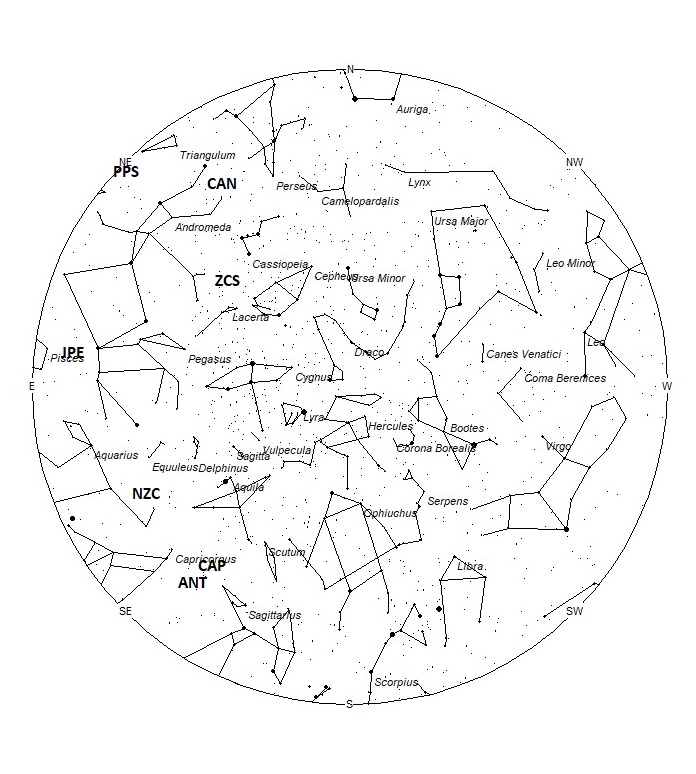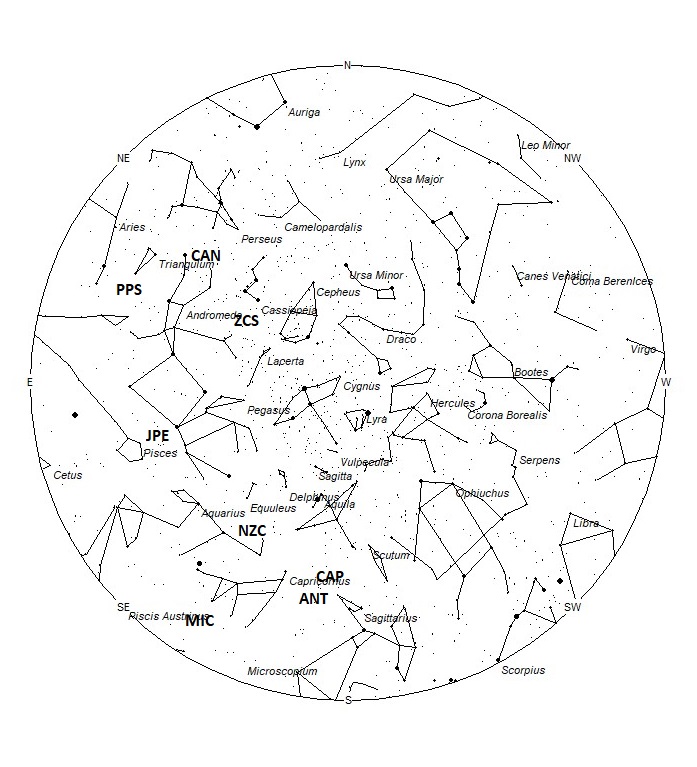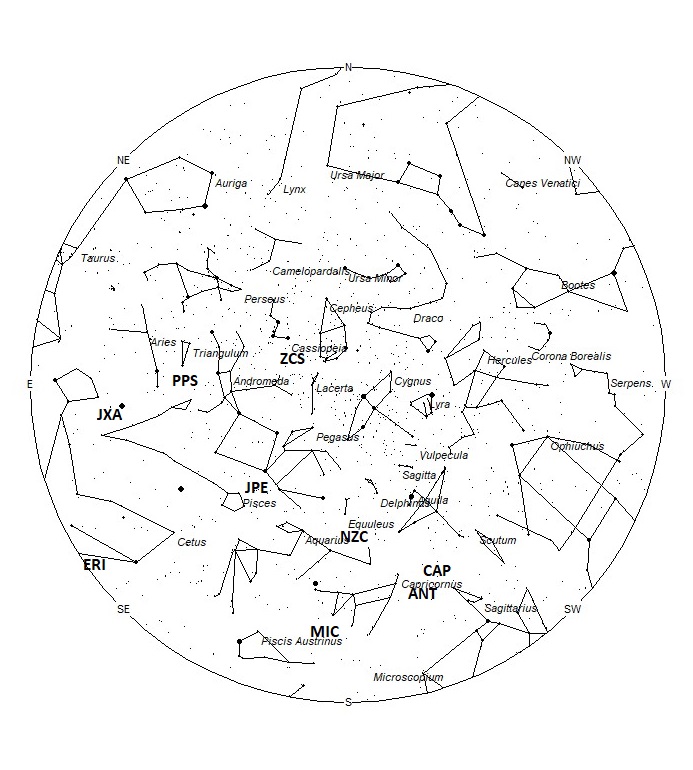During this period, the moon reaches its full phase on Wednesday July 13th. At that time the moon is located opposite the sun and remains above the horizon all night long. This weekend the waxing gibbous moon will set during the early morning hours, allowing a few hours of observing time under dark skies. The estimated total hourly rates for evening observers this week should be near 2 as seen from mid-northern latitudes (45N) and 2 as seen from tropical southern locations (25S) For morning observers, the estimated total hourly rates should be near 12 as seen from mid-northern latitudes (45N) and 13 as seen from tropical southern locations (25S). Evening rates are reduced due to interfering moonlight. The actual rates will also depend on factors such as personal light and motion perception, local weather conditions, alertness, and experience in watching meteor activity. Note that the hourly rates listed below are estimates as viewed from dark sky sites away from urban light sources. Observers viewing from urban areas will see less activity as only the brighter meteors will be visible from such locations.
The radiant (the area of the sky where meteors appear to shoot from) positions and rates listed below are exact for Saturday night/Sunday morning July 8/9. These positions do not change greatly day to day so the listed coordinates may be used during this entire period. Most star atlases (available at science stores and planetariums) will provide maps with grid lines of the celestial coordinates so that you may find out exactly where these positions are located in the sky. I have also included charts of the sky that display the radiant positions for evening, midnight, and morning. The center of each chart is the sky directly overhead at the appropriate hour. These charts are oriented for facing south but can be used for any direction by rotating the charts to the desired direction. A planisphere or computer planetarium program is also useful in showing the sky at any time of night on any date of the year. Activity from each radiant is best seen when it is positioned highest in the sky, either due north or south along the meridian, depending on your latitude. It must be remembered that meteor activity is rarely seen at the radiant position. Rather they shoot outwards from the radiant, so it is best to center your field of view so that the radiant lies at the edge and not the center. Viewing there will allow you to easily trace the path of each meteor back to the radiant (if it is a shower member) or in another direction if it is sporadic. Meteor activity is not seen from radiants that are located far below the horizon. The positions below are listed in a west to east manner in order of right ascension (celestial longitude). The positions listed first are located further west therefore are accessible earlier in the night while those listed further down the list rise later in the night.
These sources of meteoric activity are expected to be active this week.
.
The alpha Capricornids (CAP) are active from July 7 through August 15, peaking on July 31st. The radiant is currently located at 19:42 (295) -14. This position lies in northeastern Sagittarius, 6 degrees west of the naked eye double star known as (alpha Capricornii). Current rates are expected to be less than 1 per hour as seen from the Northern Hemisphere and near 1 per hour as seen from south of the equator. These meteors are best seen near 0100 local Summer Time (LST), when the radiant lies highest in the sky. With an entry velocity of 26 km/sec., the average meteor from this source would be of slow velocity.
The large Anthelion (ANT) is currently centered at 20:00 (300) -20. This position lies in northeastern Sagittarius, 8 degrees southwest of the 3rd magnitude star known as Dabih (beta Capricorni Aa). This radiant is best placed near 01:00 LST when it lies on the meridian and is highest in the sky. Rates at this time should be near 1 per hour as seen from the Northern Hemisphere and 2 as seen from south of the equator. With an entry velocity of 30 km/sec., the average Anthelion meteor would be of slow velocity.
The Northern June Aquilids (NZC) were discovered by Zdenek Sekanina in 1976. These meteors are active from June 26 through July 22 with maximum activity occurring on July 15. The radiant is currently located at 21:01 (315) -04. This area of the sky is located on the Aquila/Aquarius border, 4 degrees northeast of the faint star known as 3 Aquarii. This radiant is best placed near 0200 LST, when it lies on the meridian and is located highest in the sky. Hourly rates at this time should be less than 1 no matter your location. With an entry velocity of 38 km/sec., the average meteor from this source would be of medium-slow velocity. An interesting fact about this source is that it may be related to the Northern delta Aquariids of August. Where and when this source ends coincides with the start and position of the Northern delta Aquariids.
The Microscopiids (MIC) were discovered by G. Gartrell and W. G. Elford, in their study of Southern Hemisphere meteor streams. This stream is active from June 25 through July 16 with maximum activity occurring on July 6. The radiant is currently located at 21:28 (322) -27. This area of the sky is located in the northwestern Piscis Austrinus, 4 degrees south of the 4th magnitude star known as zeta Capricornii. This radiant is best placed near 0300 LST, when it lies on the meridian and is located highest in the sky. Hourly rates at this time should be less than 1 no matter your location. With an entry velocity of 40 km/sec., the average meteor from this source would be of medium-slow velocity. This shower is synonymous with the Southern June Aquilids (SZC).
The July Pegasids (JPE) are active from July 4th through August 8th with maximum activity occurring on July 11th. The radiant is currently located at 23:10 (347) +11. This area of the sky is located in southern Pegasus, 4 degrees south of the 2nd magnitude star known as Markab (alpha Pegasi). This radiant is best placed near 0400 LST, when it lies on the meridian and is located highest in the sky. Rates are expected to be near 1 per hour this week no matter your location. With an entry velocity of 64 km/sec., the average meteor from this source would be of swift velocity.
The zeta Cassiopeiids (ZCS) were discovered Przemysław Zoładek and Mariusz Wisniewski during a Polish meteor workshop in 2005 and also by members of the Croatian Meteor Network. These meteors are active from July 7-22 with maximum activity occurring on July 16. The current position of the radiant is 23:57 (359) +49. This position lies in on the Cassiopeia/Andromeda border, 3 degrees northeast of the faint star known as psi Andromedae. Rates are currently expected to be less than 1 per hour no matter your location. These meteors are best seen near during the last dark hour of the night when the radiant lies highest in a dark sky. Observers in the northern hemisphere are better situated to view this activity as the radiant rises much higher in the sky before dawn compared to southern latitudes. With an entry velocity of 55 km/sec., the average zeta Cassiopeiid meteor would be of swift speed.
The first eta Eridanids (ERI) of the season may be seen this week from a radiant near 01:16 (019) -23. This position lies in southern Cetus, 8 degrees southwest of the 4th magnitude star known as nu Ceti. This source is active until September 10th, with maximum activity occurring on August 6th. Current rates would be less than 1 per hour no matter your location. These meteors are best seen during the last dark hour prior to dawn when the radiant lies highest above the horizon in a dark sky. It should be noted that this radiant rises during twilight for the northern half of the Northern Hemisphere. Therefore, these meteors are not visible until later in the activity period when nights become longer for the Northern Hemisphere. With an entry velocity of 64 km/sec., the average meteor from this source would be of swift speed.
The phi Piscids (PPS) have been found to be comprised of two components with separate activity periods. Component B is active from July 2-22 with maximum activity occurring on July 10th. The radiant currently lies at 01:23 (021) +28. This position lies in northeastern Pisces, 4 degrees west of the 3rd magnitude star known as Mothallah (alpha Trianguli). Current rates should be near 1 meteor per hour no matter your location. This area of the sky lies highest in a dark sky during the last hour prior to dawn. The mean velocity of 66km/sec. would produce swift meteors.
The c-Andromedids (CAN) were discovered by Sirko Molau and Juergen Rendtel using video data from the IMO network. Activity from this source is seen from June 21 through July 28 with maximum activity occurring on July 12. The radiant currently lies at 02:01 (030) +48, which places it on the Andromeda/Perseus border, 6 degrees north of the famous 2nd magnitude double star known as Almach (gamma Andromedae A). This area of the sky is best seen during the last dark hour before dawn when the radiant lies highest in a dark sky. Observers in the northern hemisphere are better situated to view this activity as the radiant rises much higher in the sky before dawn compared to southern latitudes. Current rates would be less than 1 per hour no matter your location. With an entry velocity of 57 km/sec., the average meteor from this source would be of swift velocity.
The July chi Arietids (JXA) were discovered by two investigating teams in Europe using video data from European video Meteor Network Database (EDMOND), SonotaCo, 2013; and CMN, 2013. Activity from this stream is seen from June 26 through July 22 with maximum activity occurring on July 7. The radiant currently lies at 02:10 (032) +08, which places it in extreme northwestern Cetus, 1 degree southwest of the 4th magnitude star known as xi1 Ceti. This position is also just 3 degrees south of the 1st magnitude orange planet Mars. This area of the sky is best seen during the last dark hour before dawn when the radiant lies highest in a dark sky. Current rates are expected to be less than 1 no matter your location. With an entry velocity of 68 km/sec., the average meteor from this source would be of swift velocity.
As seen from the mid-northern hemisphere (45N) one would expect to see approximately 8 sporadic meteors per hour during the last hour before dawn as seen from rural observing sites. Evening rates would be near 1 per hour. As seen from the tropical southern latitudes (25S), morning rates would be near 8 per hour as seen from rural observing sites and 1 per hour during the evening hours. Locations between these two extremes would see activity between the listed figures. Evening rates are reduced during this period due to moonlight.
You can keep track of the activity of these meteor showers as well as those beyond the limits of visual observing by visiting the NASA Meteor Shower Portal available at: https://meteorshowers.seti.org/ You can move the sky globe to see different areas of the sky. Colored dots indicate shower meteors while white dots indicate sporadic (random) activity. The large orange disk indicates the position of the sun so little activity will be seen in that area of the sky.
The list below offers the information from above in tabular form. Rates and positions are exact for Saturday night/Sunday morning except where noted in the shower descriptions.
| SHOWER | DATE OF MAXIMUM ACTIVITY | CELESTIAL POSITION | ENTRY VELOCITY | CULMINATION | HOURLY RATE | CLASS |
| RA (RA in Deg.) DEC | Km/Sec | Local Summer Time | North-South | |||
| alpha Capricornids (CAP) | Jul 31 | 19:42 (295) -14 | 26 | 02:00 | <1 – 1 | II |
| Anthelion (ANT) | – | 20:00 (300) -20 | 30 | 02:00 | 1 – 2 | II |
| Northern June Aquilids (NZC) | Jul 15 | 21:01 (315) -04 | 38 | 03:00 | 1 – 1 | IV |
| Microscopiids (MIC) | Jul 06 | 21:28 (322) -27 | 40 | 03:00 | <1 – <1 | IV |
| July Pegasids (JPE) | Jul 11 | 23:10 (347) +11 | 65 | 05:00 | 1 – 1 | II |
| zeta Cassiopeiids (ZCS) | Jul 16 | 23:57 (359) +49 | 55 | 06:00 | <1 – <1 | IV |
| eta Eridanids (ERI) | Aug 06 | 01:16 (019) -23 | 64 | 08:00 | <1 – <1 | IV |
| phi Piscids (PPS) | Jul 10 | 01:23 (021) +28 | 66 | 08:00 | 1 – 1 | IV |
| c-Andromedids (CAN) | Jul 12 | 02:01 (030) +48 | 58 | 09:00 | <1 – <1 | IV |
| July chi Arietids (JXA) | Jul 07 | 02:10 (032) +08 | 68 | 09:00 | <1 – <1 | IV |




